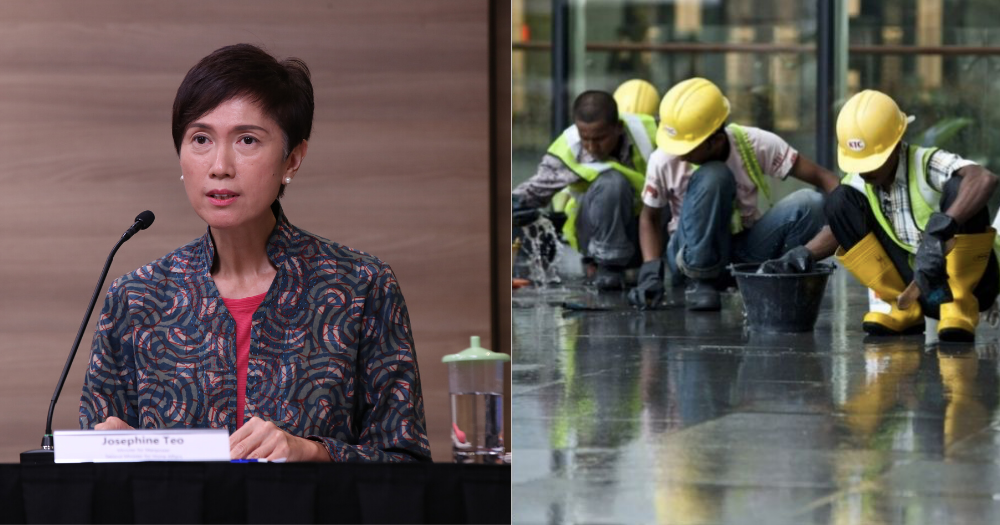In a press conference on Apr. 14, Minister of Manpower, Josephine Teo, announced a three-pronged strategy to limit the spread of Covid-19, mainly in purpose-built dormitories.
She explained that purpose-built dormitories are large-scale facilities, which house about 3,000 to 25,000 workers each.
In Singapore, there are 43 purpose-built dormitories, which house a total of about 200,000 workers.
Three-pronged strategy to limit the spread of Covid-19 in dormitories
1. Lockdown of dormitories where clusters have emerged
Teo announced that the dormitories, where clusters have already emerged, will be subject to a lockdown.
The lockdown entails the following for the workers:
- No movement in and out of the dormitories
- Workers have to stay in their rooms
- Meals are provided to avoid communal cooking and interaction amongst workers
- Scheduled staggered shower times for communal toilets
- Testing workers to identify and isolate infected individuals
At the same time, Teo mentioned that the health of non-infected individuals will be closely monitored.
2. Prevent clusters from forming in non-affected dormitories
According to Teo, 29 of the 43 purpose-built dormitories do not have clusters.
At the same time, almost all of the smaller-scale dormitories, such as factory-converted dorms, which house about 50 to 500 individuals each, have no clusters.
The second part of the strategy by the inter-agency taskforce aims to prevent clusters from forming at these smaller facilities.
Those who have tested positive for Covid-19 in non-affected dormitories, and their close contacts, have already been isolated separately.
Teo then added that dormitories, that do not have clusters, are effectively on lockdown:
"While these dorms are not gazetted as isolation areas, we aim to apply the same safe distancing measures, so that they are effectively also on lockdown.
Likewise, the workers have to stay in the dorms. Within the dorms, we enforce strictly the safe distancing measures, which means no more cooking and freely mixing with friends from other housing units."
3. Workers in essential services moved to separate facilities
The third part of the strategy that was announced by Teo is that about 7,000 workers in essential services have been moved to separate facilities.
Teo explained that this is so that they "they do not have to enter and leave the dorms daily or interact with the other dorm residents".
Before these individuals who work in the essential services were moved to alternative accommodation, they underwent medical screening, said Teo.
While working in the essential services, all workers are to abide by the same safe distancing measures as all Singaporeans.
According to Teo, they will be required to wear a mask at all times, not interact with other workers, eat their meals alone and remain in their accommodation outside of work hours.
Teo emphasised that employers of these essential workers will be held responsible and have to ensure their workers are safe.
Various agencies deployed to dormitories
According to Teo, various officers from agencies, such as Singapore Police Force (SPF), Singapore Armed Forces (SAF) and Ministry of Health (MOH) have been deployed to the 43 purpose-built dormitories.
The officers from the different agencies will address issues with food, cleanliness and health of the workers.
Teo said that the priority of the officers is the well-being of the workers:
"They understand the mission to put the well being of the workers as the top of their priority."
Seven medical outposts set up at gazetted dorms
Medical support teams, consisting of doctors, nurses, and technicians, have been deployed to these dormitories to tend to workers who are unwell.
Those with acute respiratory symptoms are tested for Covid-19 infection and the healthcare teams will assess if the workers are well enough to be returned to their rooms, or if they need to be sent to other facilities.
According to Teo, the presence of the medical teams in the dormitories gave great confidence to the workers who are there.
As of today, seven medical outposts set up at the gazetted dorms and the inter-agency taskforce aims to have medical facilities at all 43 large-scale purpose-built dorms.
Attending to the other needs of workers
Besides medical facilities, the teams deployed to the purpose-built dormitories will help to expands isolation facilities and help the workers to remit money to their home countries.
Teo added that a large part of their well-being is tied to their ability to continue receiving their salaries, as it is important to the workers.
While she acknowledged that there will be quite a lot of social adjustments required of the workers living in the dormitories, she mentioned that:
"There will be a lot of adjustments required of our workers living in the dormitories. They cannot go to work or meet their friends. We would have to help them adjust, to keep them safe and healthy.
In summary, we thank the workers for their cooperation. We have a responsibility to these workers and we will do everything we can to take care of them."
Top photos by Josephine Teo/Facebook and LKYSPP
If you like what you read, follow us on Facebook, Instagram, Twitter and Telegram to get the latest updates.
